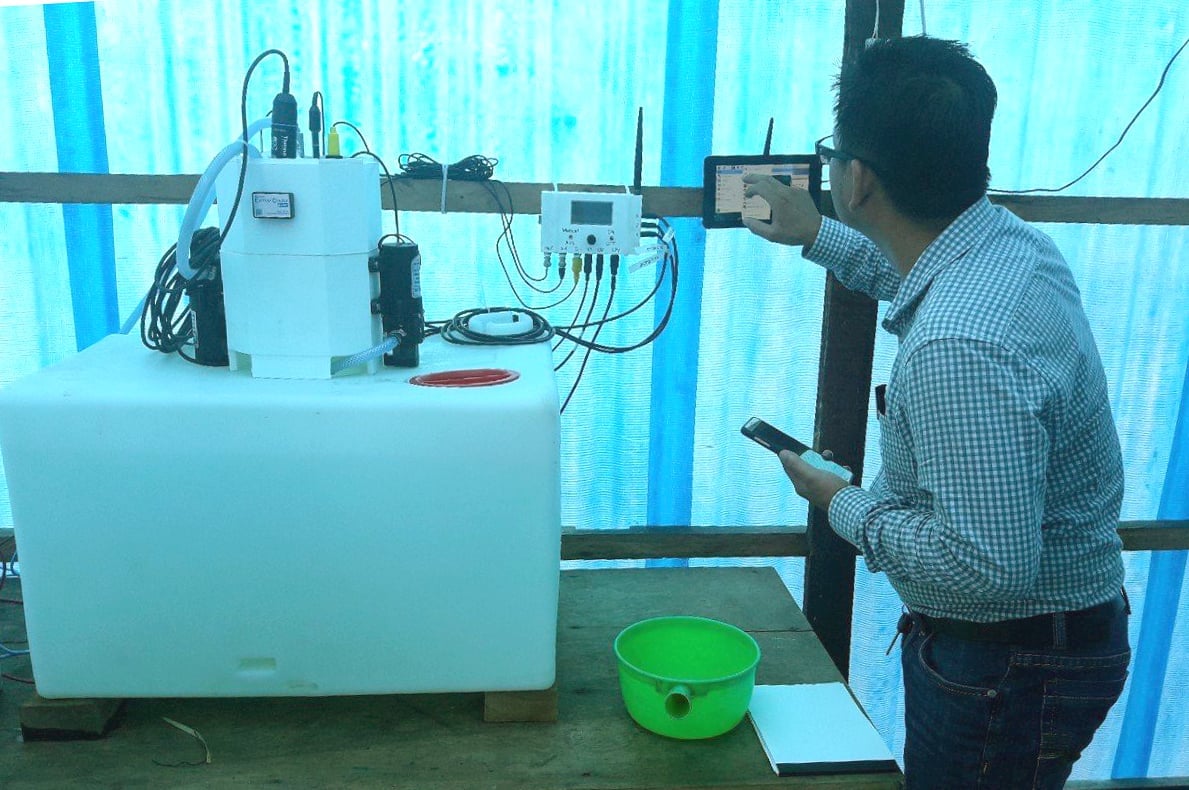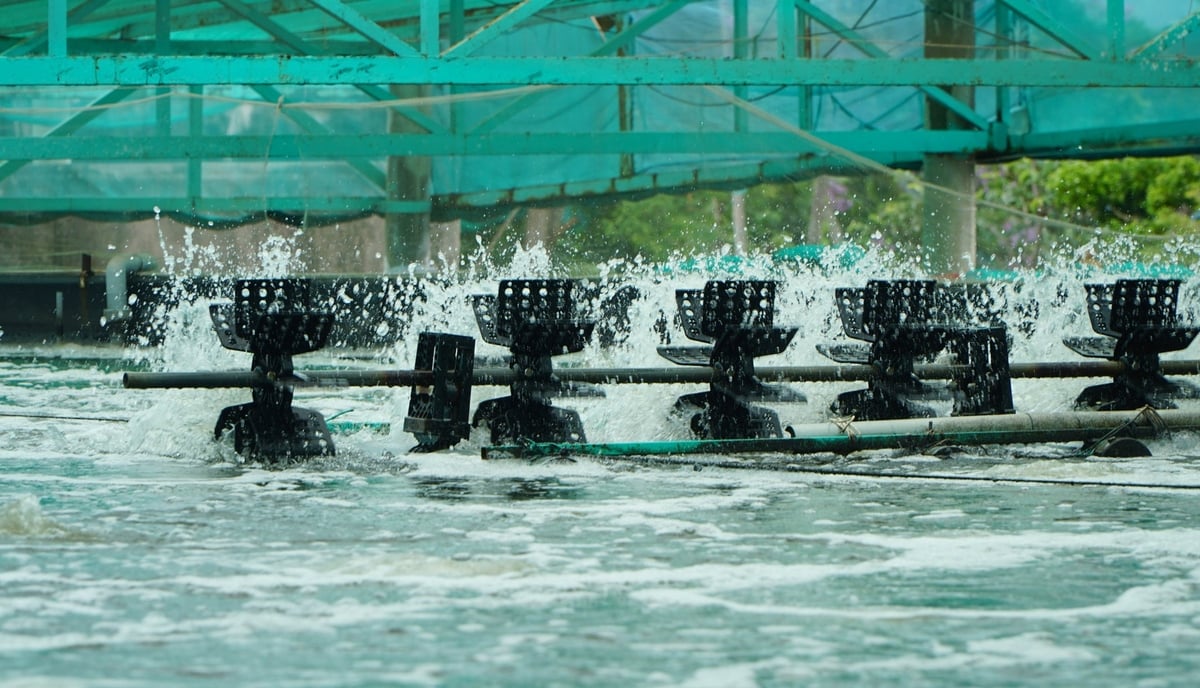October 3, 2025 | 11:56 GMT +7
October 3, 2025 | 11:56 GMT +7
Hotline: 0913.378.918
October 3, 2025 | 11:56 GMT +7
Hotline: 0913.378.918
For many years, disease has been the biggest fear of shrimp farmers. In key farming areas, a single outbreak of white spot disease or acute hepatopancreatic necrosis can result in the loss of tens of tons of shrimp in just a few days, leading to billions of VND in losses. Water pollution, climate change and extreme weather further increase this risk.

Green AIoT project members are operating the system at a pilot model in Long Son commune (Ho Chi Minh city). Photo: LB.
Seeing the urgency of the situation, a group of students from Industrial University of Ho Chi Minh City (IUH) and BTEC FPT HCM developed the Green AIoT system to help monitor, analyze, and forecast water quality in real time.
Green AIoT uses sensors to measure temperature, salinity, pH, dissolved oxygen, alkalinity, etc., and continuously sends data to the analysis platform. Instead of just displaying numbers, the system processes data using machine learning algorithms to detect abnormalities, for example, pH exceeding thresholds or low oxygen, then issues warnings and automatically activates aerators or adjusts water sources.
One of its highlights is the ability to predict environmental developments based on historical data. For example, when a trend of low oxygen is detected for 12 hours, the system will recommend an early water change or increased aeration, helping farmers prevent incidents before shrimp are shocked.
“Green AIoT is not just a technology system. It is a clear image of the future of smart agriculture, where AI acts as a manager to help farmers reduce risks and move towards sustainability,” said Vu Phan Minh Hai, project representative.

The current aquaculture area in Ba Ria - Vung Tau (HCMC) has exceeded 5,600 ha. Photo: Le Binh.
To expand the sample size, Green AIoT is integrated with an autonomous marine vessel (AMV). The compact vessel is equipped with positioning sensors and lidar to move around the pond, helping it collect data at multiple points instead of staying in one place. The collected information can thus accurately reflect the entire pond condition, avoiding missing “dead spots” in terms of water quality.
The system is currently being tested in Long Son commune (HCMC) and has shown positive results. Timely warnings from the system help farmers adjust aeration and change water appropriately, therefore reducing shrimp mortality rate and increasing yield.
Not stopping at AI solutions, many large-scale shrimp farms are synchronizing high technologies to prevent diseases from the root. Phan Duc Dat's farm in Phuoc Hai commune applies the CPF-Combine model on an area of 21 ha. The farm uses 18 ha for settling ponds and water treatment ponds, and the rest are for white-leg shrimp farming ponds.
CPF-Combine’s closed process helps to strictly control the water source. Water is treated through a settling pond, disinfected, and then put into the pond. Oxygenators, fans, and pH measuring devices operate continuously. The water level is maintained at 1.5 m to stabilize the temperature. "Shrimps of winter and rainy season crops are susceptible to white spot syndrome, so we pay special attention to water treatment and adding vitamins to food to increase resistance," said Dat.
The highlight of this model is the utilization of VIBOT, a biological product that uses Bacillus subtilis and Bacillus Lateosporus microorganisms to create a “fake” brown cover on the water surface. This layer helps reduce the impact of heat, ultraviolet rays and rain. At the same time, it inhibits TDP-causing bacteria, limits algae bloom, and reduces the risk of shrimp getting intestinal diseases.
Dat tests the efficiency of VIBOT on 7 farm ponds totaling 5,000m², resulting in an output of 27 tons of shrimp at a size of 25 shrimps per kg, which is an increase of 5 tons compared to ponds not applying the VIBOT technology. This also leads to a significant reduction in costs for antibiotics, lime, and vitamins.

Thanks to the application of high technology and AI in aquaculture, shrimp are better protected from diseases, while productivity and quality of the farming model are improved. Photo: Le Binh.
Information from the Department of Fisheries and Fisheries Surveillance Region III (Ho Chi Minh City Department of Agriculture and Environment) shows that in the first 5 months of 2025, the aquaculture area in Ho Chi Minh city has exceeded 5,600 ha. One thing to note is that the high-tech farming area is rapidly expanding, as there are currently 23 organizations and individuals applying advanced methods during the production process, with a total area of over 429 ha.
“Models that combine AI, IoT, microbiology, and closed processes will help farmers become proactive in the face of certain risks, reduce dependence on antibiotics, and meet the strict requirements of foreign markets such as Europe and the USA,” said Nguyen Huu Thi, Deputy Head of the Department of Fisheries and Fisheries Surveillance Region III.
Translated by Samuel Pham

(VAN) The Mekong River Commission strengthens cooperation with China and Myanmar and develops a strategic orientation for the 2026 - 2030 period.

(VAN) A loan of nearly 145 million USD from the Integrated Resilient Development Project will support Vietnam on disaster risk management and sustainable infrastructure.

(VAN) The German Agency for International Cooperation (GIZ) will support Viet Nam in technology transfer to build an affordable, net-zero energy system.

(VAN) With CPV’s co-host status, the event becomes even more attractive for industry professionals seeking strategic partnerships, market visibility, and sustainability driven solutions.

(VAN) A groundbreaking xenotransplant at Xijing Hospital in Xi'an, Shaanxi province, has set a new survival record in Asia, with a gene-edited pig kidney functioning in a patient for more than 200 days.

(VAN) The escalating misuse of antibiotics in animal husbandry is fueling the rise of antimicrobial resistance (AMR), posing a severe threat to public health and food safety.

(VAN) Viet Nam and France are deepening their strategic cooperation to foster a sustainable blue economy, protect the environment, and jointly pursue Net Zero 2050 commitments in the face of climate change.